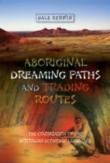 2308258997508453890.jpg
2308258997508453890.jpg
 Aboriginal Dreaming Paths and Trading Routes : The Colonisation of the Australian Economic Landscape
multi chapter work
Aboriginal Dreaming Paths and Trading Routes : The Colonisation of the Australian Economic Landscape
multi chapter work
 2308258997508453890.jpg
2308258997508453890.jpg
 Aboriginal Dreaming Paths and Trading Routes : The Colonisation of the Australian Economic Landscape
multi chapter work
Aboriginal Dreaming Paths and Trading Routes : The Colonisation of the Australian Economic Landscape
multi chapter work
'The dreaming paths of Aboriginal nations across Australia formed major ceremonial routes along which goods and knowledge flowed. These became the trade routes that criss-crossed Australia and transported religion and cultural values. This book highlights the valuable contribution Aboriginal people made in assisting European explorers, surveyors and stockmen to open the country for colonisation, and explores the interface between Aboriginal possession of the Australian continent and European colonisation and appropriation. Instead of positing a radical disjunction between cultural competencies, Dale Kerwin considers how European colonisation of Australia appropriated Aboriginal competence in terms of the landscape: by tapping into culinary and medicinal knowledge, water and resource knowledge, hunting, food collecting and path-finding. As a consequence of this assistance, Aboriginal dreaming paths and trading routes also became the routes and roads of colonisers. Indeed, the European colonisation of Australia owes much of its success to the deliberate process of Aboriginal land management practices. Dale Kerwin provides a social science context for the broader study of Aboriginal trading routes by providing an historic interpretation of the Aboriginal/European contact period. His book scrutinises arguments about nomadic and primitive societies, as well as Romantic views of culture and affluence. These circumstances and outcomes are juxtaposed with evidence that indicates that Aboriginal societies are substantially sedentary and highly developed, capable of functional differentiation and foresight -- attributes previously only granted to the European settlers. The hunter-gatherer image of Aboriginal society is rejected by providing evidence of crop cultivation and land management, as well as social arrangements that made best use of a hostile environment. This book is essential reading for all those who seek to have a better knowledge of Australia and its first people: it inscribes Aboriginal people firmly in the body of Australian history.' (Publication summary)
Table of Contents:
'Dale Kerwin has transformed his doctoral thesis into an impressive book, with an enticing title and cover. The ‘paths’ and ‘routes’ in the title refer to the vast, complex and well-used network of pathways that covered this country before Europeans arrived. This book looks at the nature of this network, its rich array of associated infrastructure, both cultural and spiritual, and the way in which it was co-opted by Europeans to take control of the Australian continent from the late eighteenth century onwards. As the series editor David Cahill notes in his preface, this is an ‘emic’ study — an ‘insider’s’ view. Thus the author, an Aboriginal scholar, brings to this study not only his voice but also the knowledge and understanding of a number of Aboriginal Elders across the continent. The six chapters are well illustrated with black and white maps, photographs and drawings, for which the front listings contain informative extra notes. There is a solid reference list and a sufficient index, a feature that is a helpful addition to the original thesis. Several of the chapter titles I found to be most intriguing and inviting.' (Introduction)
'Dale Kerwin has transformed his doctoral thesis into an impressive book, with an enticing title and cover. The ‘paths’ and ‘routes’ in the title refer to the vast, complex and well-used network of pathways that covered this country before Europeans arrived. This book looks at the nature of this network, its rich array of associated infrastructure, both cultural and spiritual, and the way in which it was co-opted by Europeans to take control of the Australian continent from the late eighteenth century onwards. As the series editor David Cahill notes in his preface, this is an ‘emic’ study — an ‘insider’s’ view. Thus the author, an Aboriginal scholar, brings to this study not only his voice but also the knowledge and understanding of a number of Aboriginal Elders across the continent. The six chapters are well illustrated with black and white maps, photographs and drawings, for which the front listings contain informative extra notes. There is a solid reference list and a sufficient index, a feature that is a helpful addition to the original thesis. Several of the chapter titles I found to be most intriguing and inviting.' (Introduction)